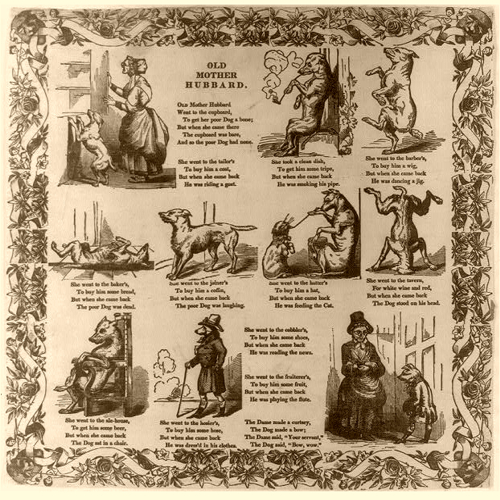
La trippa della signora Hubbard

La trippa si trova menzionata nel brevissimo racconto in rima "Old Mother Hubbard" (la vecchia Madre Hubbard). Si tratta di una antica filastrocca, attribuita a Sarah Catherine Martin e pubblicata a cominciare dal 1790, ma probabilmente derivata da una tradizione orale che risale al sedicesimo secolo. I versi di questa storiella molto nota nei paesi anglosassoni, raccontano della Madre Hubbard alle prese col suo cane. Ed è un cane davvero speciale: suona il flauto, cavalca le capre, legge il giornale e quando la vecchia signora gli serve un po' di trippa, ecco che lo trova a fumare beatamente la pipa.
("Prese un piatto pulito / Per dargli un po' di trippa / Ma quando tornò a casa / Il cane stava fumando la pipa")
Dagli inizi dell'Ottocento ad oggi la filastrocca è stata ripubblicata decine di volte, ed anche rimaneggiata: alcune versioni saltano a pie' pari i versi che parlano di trippa, altre - invece che del piatto pulito - raccontano della Madre Hubbard che si reca dal macellaio. Questa la filastrocca integrale, in lingua inglese:
|
Old Mother Hubbard
She went to the baker's
She went to the joiner's
She took a clean dish
She went to the ale-house
|
She went to the tavern
She went to the hatter's
She went to the barber's
She went to the fruiterer's
She went to the tailor's
|
She went to the cobbler's
She went to the seamstress
She went to the hosier's
The dame made a curtsey,
This wonderful dog
|
I versi della prima strofa alluderebbero al cardinale Thomas Wolsey ed al re Enrico VIII. Tramite il cardinale (la signora Hubbard), il re (il cane) cercò infatti di ottenere dalla Chiesa Cattolica l'annullamento del matrimonio con Caterina d'Aragona (l'osso) per poter sposare Anna Bolena. Ma non vi riuscì (alla Chiesa Cattolica alluderebbe la dispensa vuota) ed il rifiuto del papa Clemente VII portò allo scisma religioso con Roma da cui nacque la Chiesa anglicana.
Clicca qui per ammirare una collezione di pagine illustrate tratte da libri d'epoca.
